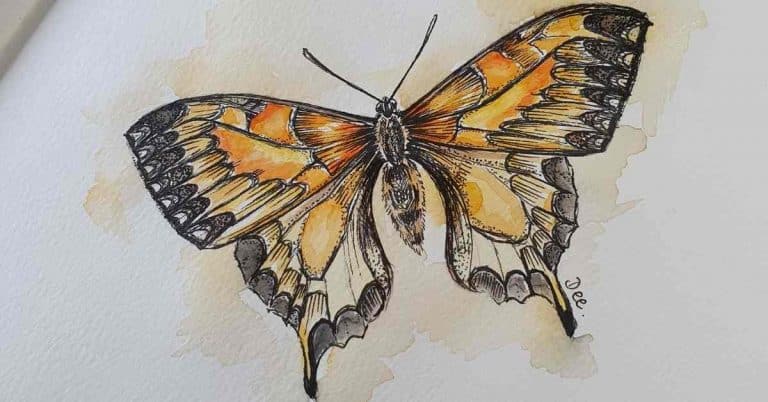Last Updated on April 28, 2023 by Dee
Butterflies come with a huge array of colors, patterns, and wing shapes. I can’t help but be fascinated with their beauty and fragility. Let’s look at how to draw a butterfly…
Butterfly Drawing Tutorial
Step 1- Collecting your reference material
Whenever you draw a plant, flower or insect, it is a good idea to get a clear and good quality reference image to work from.
Work from your imagination
You can work from your imagination, but the truth is that most people’s brains leave out important information about the original insect. As a result, the butterfly may become more stylized or simplified than the original.
If you want to paint a monarch butterfly or insect in a more abstracted or expressionistic manner, then it is absolutely fine to work with a more stylized, simplified drawing. In this case, drawing from your imagination would work well.
In this step by step drawing tutorial, I wanted to capture the smaller details and patterns on the butterfly wings.
[Related article: How to Draw Tree Roots]
Work from your own photos
Drawing from your own photos is a great way to come up with unique ideas and compositions. You also have first-hand experience of what the butterfly looks like in a real-life situation. This gives you a better idea of how the subject matter “sits in space” so to speak.
Work from a free stock photo
Because I wanted a level of naturalism in my artwork, I chose to work from a photograph of a butterfly that I found on unsplash.com.
If you cannot get your own photographs of your chosen subject matter, then you can always use free images from unsplash.com or pexel.com. There are a huge variety of free stock photo sites on the web, but these two are the ones I have used the most for good reference photos.
Step 2: Decide on the size of your drawing
I find that working on an A4 or A3 sheet of watercolor paper is a good size to start off with for drawing. The butterfly I drew is on a page in my art journal – it is slightly smaller than A4. It is square in shape, but works well for the size and structure of a butterfly.
I would recommend sticking to at least A4 in size, because if you work any smaller you may struggle to get a good amount of detail in your drawing or painting.
Interestingly enough, working on a larger surface is a lot easier than on a smaller surface.
With a larger sheet of paper, you can accentuate details and there is space to enlarge tiny areas. Your pencil marks and brush strokes can be bolder and wider – and there is more room for error in a sense.
Step 3: Composition and rough drawing of the general shapes of the butterfly
Once you have decided on the size of the paper you will be working on, you can think about your composition and then draw it out in pencil.
Think carefully about how you will position the butterfly on your page. I decided I wanted to place my butterfly at an angle to make it a more interesting composition.
I recommend using a 2B lead pencil to first softly sketch out the general shapes of the butterfly wings and body. Make sure you are applying only a very light pressure onto the pencil to achieve very light pencil marks on the page.
I started my butterfly drawing by sketching out the general circle and oval shapes of the butterfly body and then added the sections of each wing. As you can see, the pencil mark is very light, but hopefully, you can see the general shape.
I then carefully observed the patterns and lines within the wings of the butterfly and sketched those in.

Step 4: Defining Form
Once I had sketched the light shapes and lines within the butterfly, then I started going over the wings, body, and lines again and making changes and alterations to the shapes in order to get the butterfly sketch to look more accurate. I use a kneadable eraser because I find it great to be able to manipulate its shape so that I can erase lines in small places and awkward angles!
At this stage of the process, you can also use your artistic license to add elements like additional shapes or spots within the wings of the butterfly.
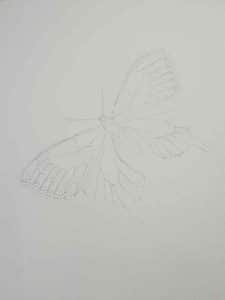
Step 5: Go over the pencil marks in pen
Once you have pencil sketched the general shapes of the butterfly and have a good idea of how it is positioned, then you can start going over your pencil lines with pen.
Because I am going to complete this illustration with watercolor washes, I have chosen a fine liner pen that is both permanent and waterproof. I like to use either the Faber Castell Pitt Pen XS to begin and then I move onto a size S nib later on when my shapes are more defined.
As you can see, I decided to start off by inking the outline of the butterfly wings, the outline of the body, and then working my way onto the lines and patterns within the wings.
You will also see that when I start out drawing with my pen, I ‘sketch’ with it. I like to have loose lines when I begin and as the drawing progresses the lines become more solid in certain areas.



Step 6: Begin shading
Remember to check where your light source is! This is so important in order to accurately draw forms and get a sense of three-dimensionality. Your shadows will fall opposite your light source.
[Related article: How to Draw Tree Roots]
You can see in the pictures I begin shading the body of the butterfly using light cross-hatching lines to building up the three-dimensional quality of the body and create a pattern.
I then move on to the shapes within the butterfly wings and use hatching to fill them in. I tend to work with denser hatching on the outer area of the shape and leave the mid-section of each shape empty. This helps to create a sense of translucency to the wings.
Its a good idea to always start drawing from the top corner that is opposite your dominant hand. This prevents you from accidently rubbing or smudging your drawing as you work.
For this reason, I started my butterfly pen drawing from the top left corner and completed the top sections of the wings first, before moving to the lower sections of the wings.
There are several shading techniques you can use to shade in your sunflower drawing – cross-hatching, hatching, scribbling, stippling, and grading. You can use these shading techniques for pencil, pen, markers, pastels (pretty much all dry media) and achieve shadows and highlights and a sense of three-dimensionality.
[Related Post: The Ultimate List of Fun Things to Draw!]
I personally find that using a combination of shading techniques to build up the density of form and deepen my shadows works really well.

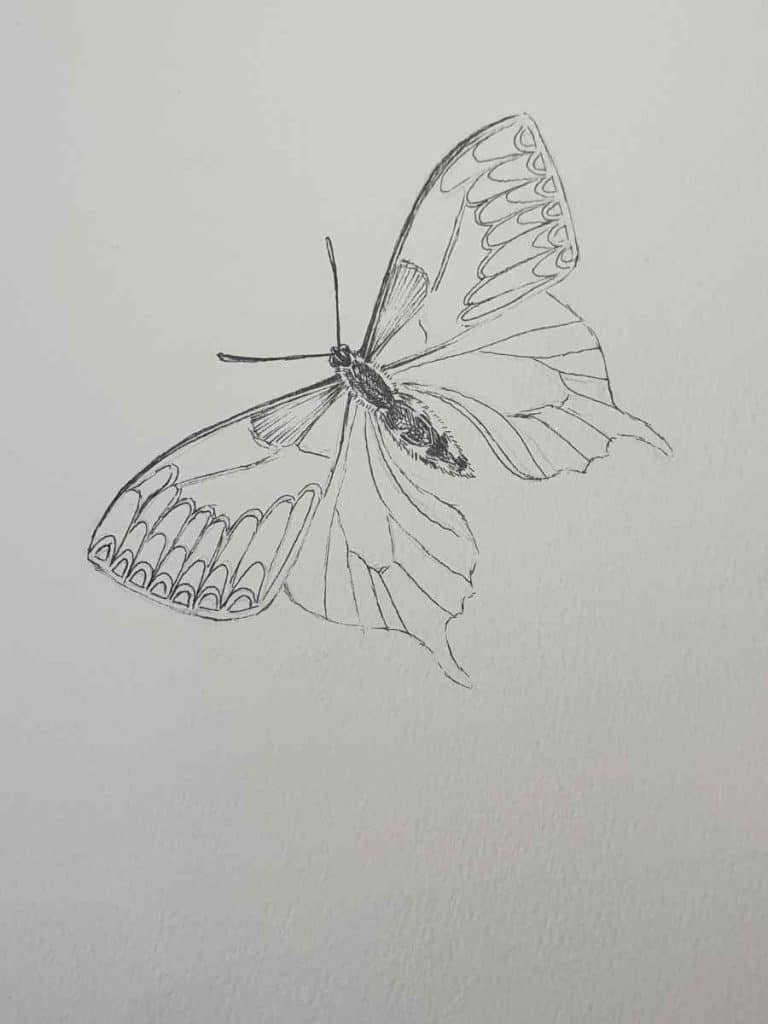
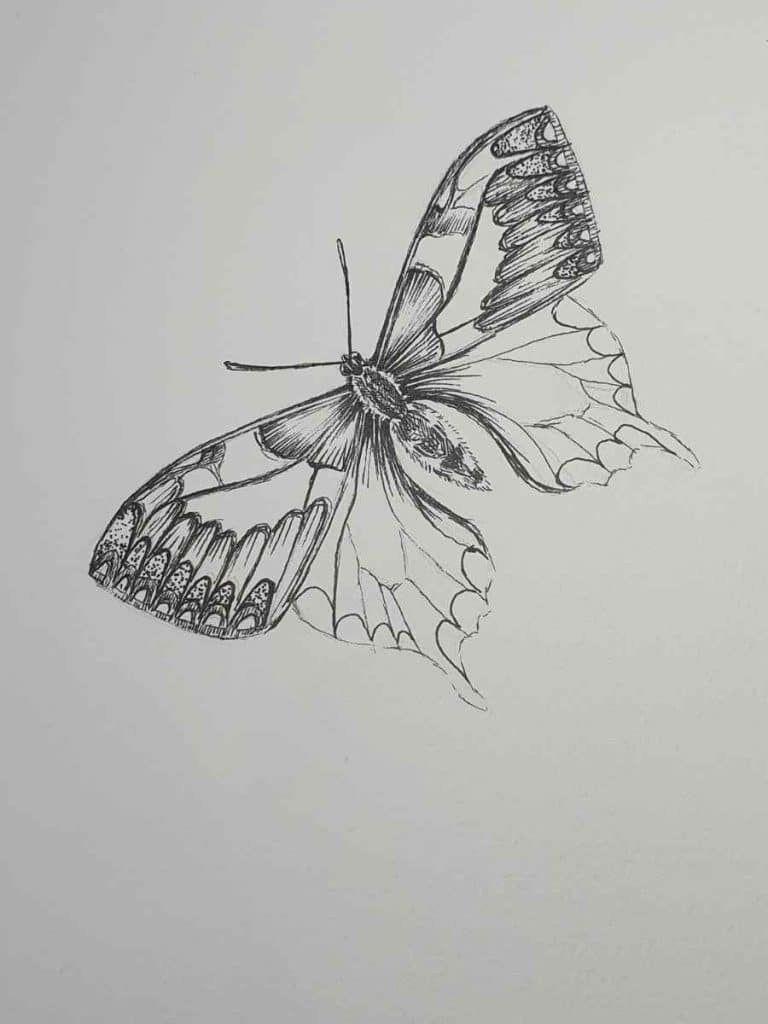
Step 7: Final details
I like to stand back and observe what areas of my drawing need to be darkened and what needs to be lightened. A good drawing has a balance of very light and very dark areas.
I continue to deepen my butterfly shadows or darker areas.
Use your kneadable eraser to remove final pencil marks in order to lighten specific areas.
If you would like to take your butterfly species a step further, you can turn it into a butterfly painting. Add color to your sunflower by applying soft washes of watercolor paint over the pen.

Step 8: Paint washes of your lightest color
As you begin painting with watercolor you will be using a technique called wet-on-dry. Essentially that means you are putting paint on your paintbrush and then painting directly onto the dry surface of the page. This is a good way to start because you have more control over the areas you are painting color.
Once you have defined your shapes using your initial color you can then work into them using a technique called wet-on-wet.
Wet-on-wet is where you paint you paint your watercolor paint onto a watery surface. The color then blooms and bleeds and creates interesting washes of color. This is less controlled than wet-on-dry, but I love watching how the watercolor pigment creates gorgeous textures and patterns as it dries.
I started by painting very soft washes of yellow into the shapes of the butterfly wings.

[Related Post: How to Paint Gorgeous Cherry Blossoms]
Step 9: Layers of washes to the darker areas
Continue to paint layers of washes on top of one another to build up depth and deepen shadow areas. As you can see, I used orange over the yellow to add interest and depth to the wings.
Step 10: Washes Paynes Grey
Finally, I painted washes of Paynes Grey over the darker patterns on the butterfly wings.
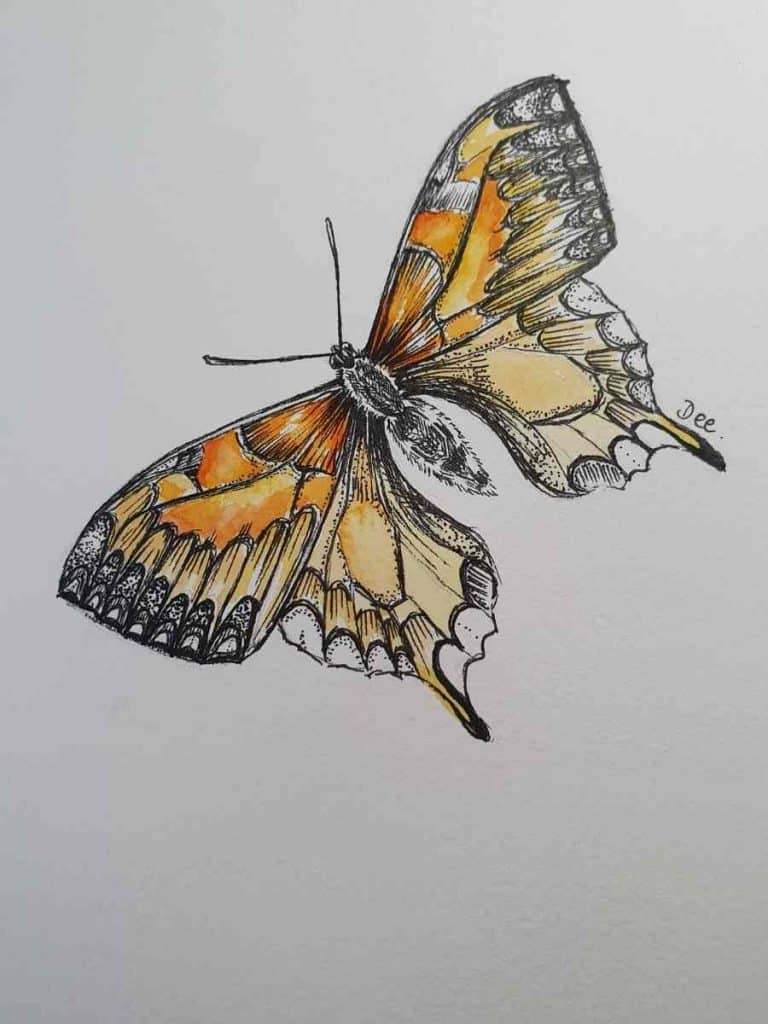
How to Draw a Simple Butterfly
If you would like to draw a simple butterfly you can follow my step-by-step guide below.

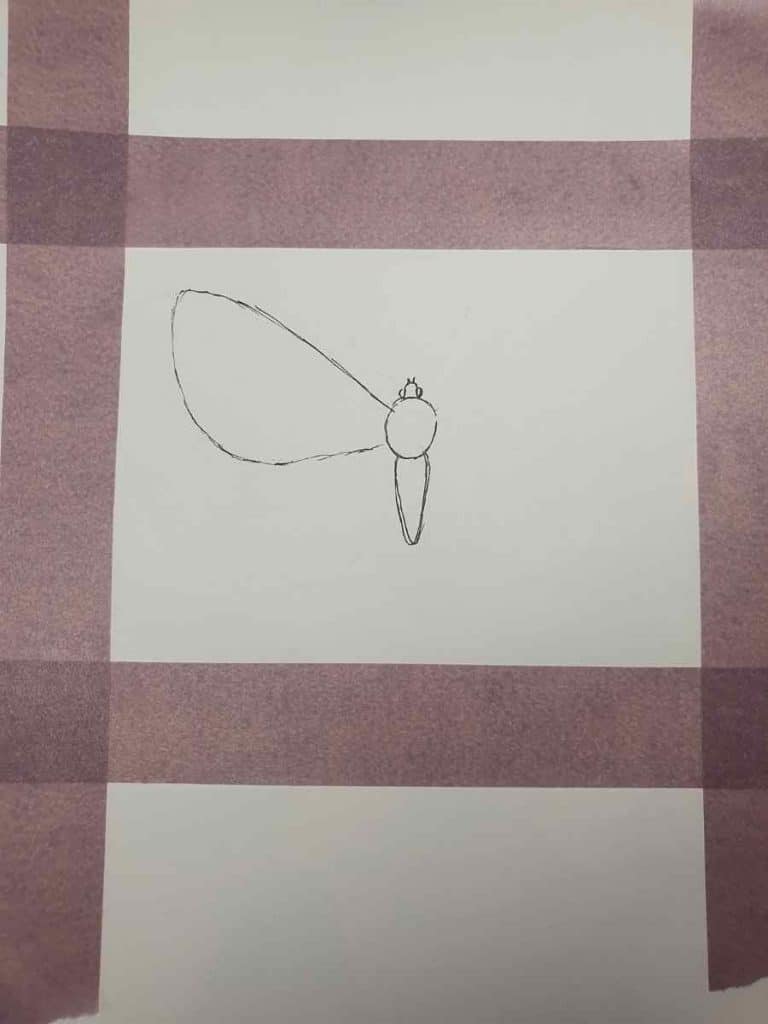



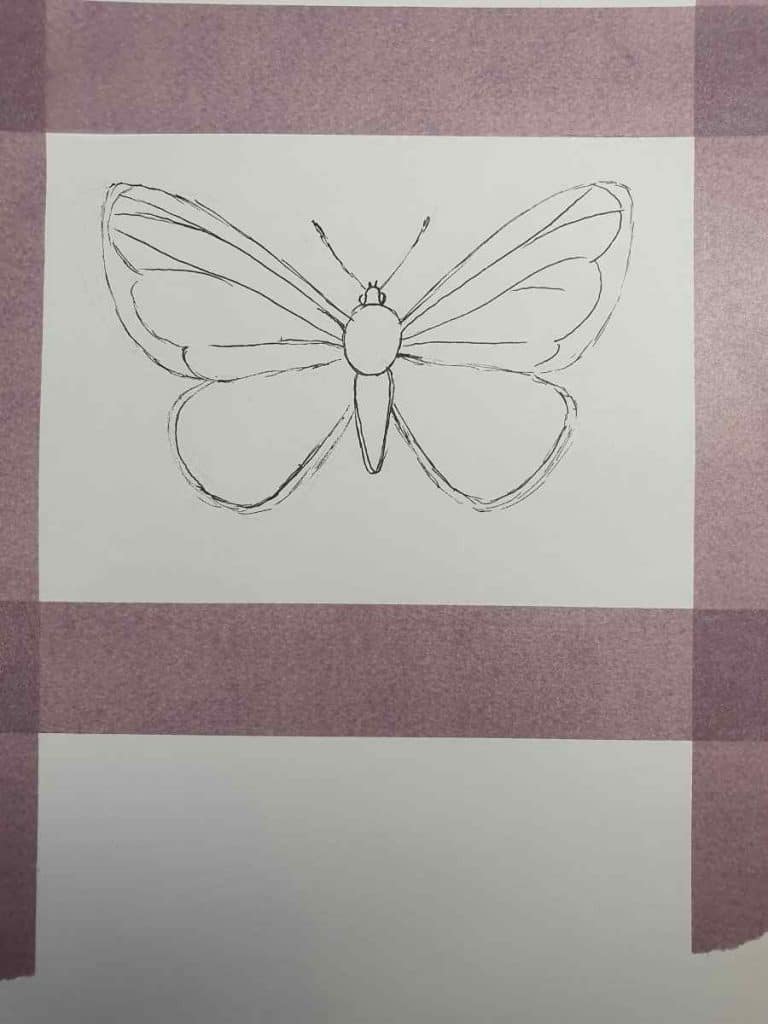


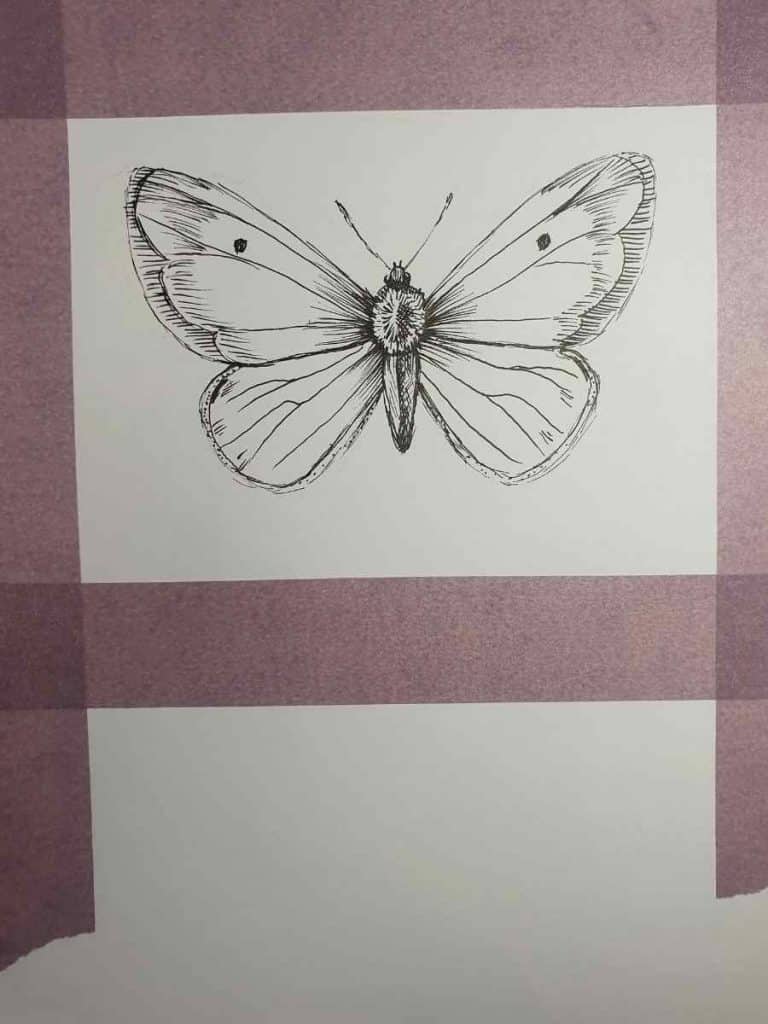
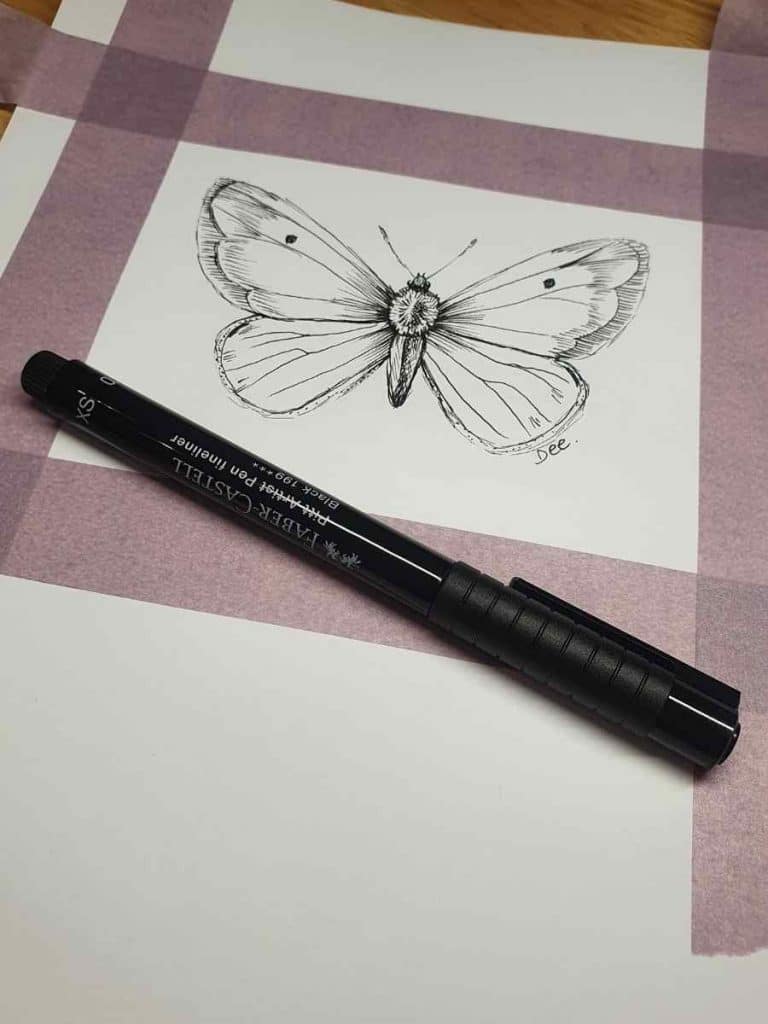
Step 1: Draw the basic middle line, circle and oval shapes of the butterfly’s body.
Step 2 to Step 4: Draw two curved lines for each section of the wings on the right and left.
Step 5 to Step 6: Fill in the diagonal lines and basic patterns within the butterfly wings.
Step 7: Shade the body of the butterfly.
Step 8: Add some hatching to a few of the shapes on the upper part of each wing.
Step 9: Add some shading to where the body meets the wings and some stippling to the edges of the wings.
Step 10: Finished!
Remember the following when drawing…
Make sure to stand back regularly to observe how your drawing is developing. It is also important that you give yourself mental and visual breaks so that you can continue to draw accurately.
Remember to keep your pencil sharp. This is important because we often get so engrossed in our drawing that we forget that a sharp pencil helps with fine lines and details.
It is a good idea to always have a scrap piece of paper nearby, in order to test out your shapes and shading techniques!
[Related article: How to Draw a Background]
List of materials and supplies needed to do your own pencil or pen butterfly drawing or butterfly watercolor painting.
The Best Painting and Drawing Supplies for Artists2B, 4B, 6B and 8B Pencil
Scrap piece of paper for testing colors
300gsm Watercolor Paper: If you want to add a wash to your drawing you should definitely do your drawing on good-quality, heavy paper that doesn’t buckle.
Soft Bristle Round or Filbert Brush
Watercolor pans or tubes. I am currently using the Windsor and Newton Watercolor Pan. The colors are rich, and the tray is portable and easy to use.

Conclusion
Drawing a butterfly is a fun and easy sketching project for beginners and more advanced artists. I hope you have found my advice on techniques and materials to be useful as you begin your own art. Make sure to join our email list for more drawing tutorials.
Other articles you may enjoy…
